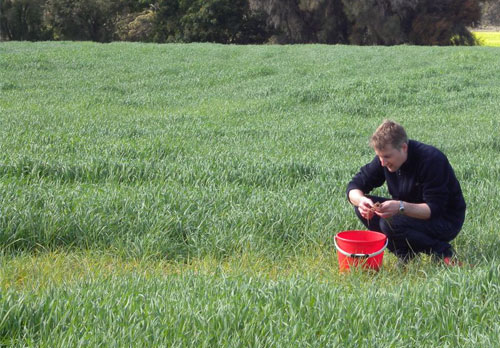|
Western Australia - New cereal disease treatment on the horizon for rhizoctonia
Western Australia
May 20, 2014

Department of Agriculture and Food research officer Dr Daniel Hüberli checks a barley crop at Darkan for rhizoctonia bare-patch, for which a trial fungicide treatment is showing much promise.
There could finally be a fungicide option to reduce the impact of the widespread cereal disease rhizoctonia bare-patch, which costs the grains Western Australian industry $27 million each year.
A collaboration between the Department of Agriculture and Food (DAFWA) and the South Australian Research and Development Institute and two chemical companies, funded by the Grains Research and Development Corporation, has found significant benefits from liquid banding with two new fungicides.
DAFWA research officer Daniel Hüberli said this was the first time an effective chemical option to control the disease was available.
“Wheat and barley trials in WA and South Australia have shown that liquid banding with Unifiorm™, one of the new fungicides, increased yields by up to 0.87 tonnes per hectare in a paddock with very high levels of rhizoctonia in the soil before sowing,” Dr Hüberli said.
The best results were achieved when the fungicides were applied as a split application on the soil surface behind the press wheel and in-furrow three centimetres below the seed.
“In wheat, the yield response increased by 0.11-0.39 tonnes per hectare, with a medium rate split application, while at a higher rate the yield was 0.23-0.53t/ha more than the untreated control,” Dr Hüberli said.
“For barley, there was a 0.25-0.69t/ha yield improvement from a medium rate and 0.37-0.87t/ha from the high rate.”
Applying the fungicide in a single band below the seed still produced significant yield increases of between 0.09-0.47t/ha from different rates in wheat and 0.17-0.69t/ha in barley.
The Australian Pesticides and Veterinary Medicines Authority has approved permits for large-scale trials this season by the chemical companies and is considering an application for registration, which, if approved, could make the products available in 2015.
Growers will be able to view the trials in demonstration paddocks at local field days.
But Dr Hüberli warned that growers should not rely on fungicides alone to protect their crops from rhizoctonia.
“Fungicide should be used as part of an integrated disease management program, which can include sowing a break crop, like canola, chemical fallow and controlling autumn weeds,” he said.
“Sowing early, soil disturbance 10 centimetres below the seed using knife-points and ensuring adequate nitrogen are other useful strategies.”
For more information about controlling rhizoctonia bare-patch visit DAFWA’s grains pages at agric.wa.gov.au
More news from:
. Western Australia, Department of Primary Industries
. SARDI (South Australian Research & Development Institute)
Website: http://www.agric.wa.gov.au Published: May 20, 2014 |
|
The news item on this page is copyright by the organization where it originated
Fair use notice |